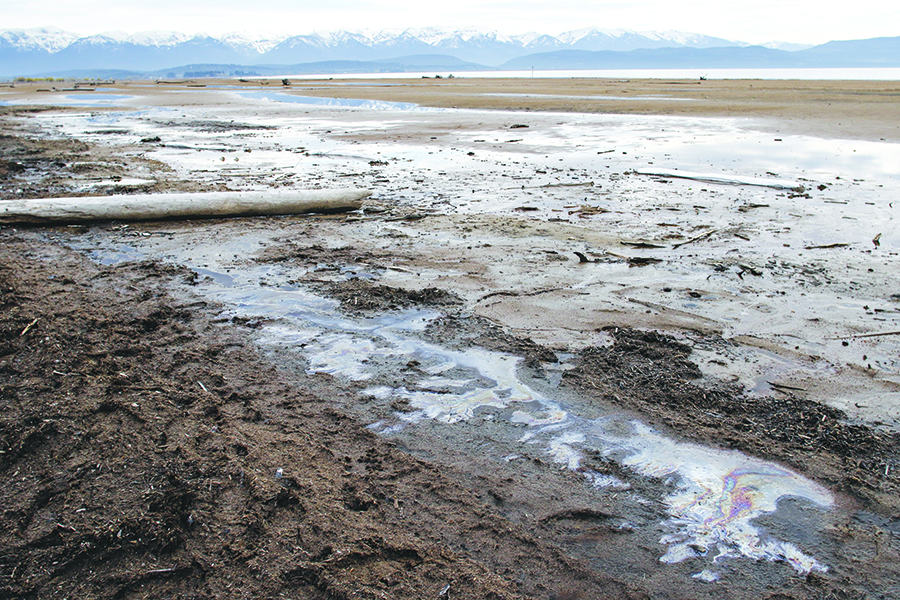BNSF, EPA Plan Shoreline Stabilization Project in Somers
Agencies worry continued erosion could impact Superfund site; county commission expresses frustration for not being involved in planning
By Justin Franz
BNSF Railway, the U.S. Environmental Protection Agency and the Montana Department of Environmental Quality are looking to stabilize a short section of the north shore of Flathead Lake to ensure contaminants from the Somers Tie Plant Superfund site do not contaminate the largest natural freshwater lake in the West.
On Feb. 27, officials with BNSF, the EPA and DEQ gave an overview of the project to the Flathead County Commission in Kalispell. Because the project is taking place at a Superfund site, state and federal agencies don’t need permission from the county to move forward. EPA Project Manager Roger Hoogerheide said the presentation was a “courtesy” to let local officials know it was happening and that there would be increased truck traffic through Somers during construction.
But the three-person commission chided state and federal officials for not involving county officials in the plan sooner, with Commissioner Gary Kruger saying he was “disgusted.” The commission was mostly concerned that the stabilization project could adversely impact other landowners along the lake.
“I do not want a release of contaminants into Flathead Lake from that site, but I also want the public to be involved in the fix,” Kruger said. “I’m disgusted that we were not brought into the process.”
BNSF predecessors Great Northern Railway and Burlington Northern operated a railroad tie production plant in Somers from 1901 to 1986. In the early years, logs were floa ted into Somers Bay, where they were fished out of the water and cut into ties that were treated with creosote to protect them from the elements. When the plant was in operation, wastewater was directed to an area adjacent to Flathead Lake called the “swamp pond.”
In the mid-1980s, the lakeside factory was designated a Superfund site. In 1994, the EPA, DEQ and BNSF contractors began excavating and treating 50,000 cubic yards of soil and the groundwater underneath the site. Soil remediation was completed in 2002. Since then, the railroad and regulators have continued to monitor the site.
In May 2017, an oily substance was discovered along the shores of Flathead Lake. Local and federal officials determined that the level of contamination on the shore was low but needed to be addressed. The EPA began looking at ways to prevent additional contamination from the “swamp pond” and surrounding Superfund site from entering the lake.
Complicating matters is the north shore’s continued erosion due to operations at the Seli’š Ksanka Qlispe’ Dam (formerly the Kerr Dam) near Polson. Since 1985, the BNSF-owned shoreline has retreated up to 125 feet in some areas due to erosion, and currently only an average of 15 feet of land separates the lake from the swamp pond. On average, the shoreline retreats two to six feet annually.
To help protect the swamp pond, BNSF, the EPA and DEQ have come up with a plan to add a natural barrier between it and the lake. The barrier would consist of soil, woody debris, trees and shrubs and would stretch roughly 250 feet along the shore. About 1,000 cubic yards of material would be used.
Hoogerheide, the EPA manager, said it’s critical that the project be completed this spring before the lake level is increased for summer recreation. Officials hope to begin construction late this month. BNSF officials present at the meeting, as well as Richard Sloan, a project manager for DEQ, echoed the project’s urgency.
“We do not want to see this project delayed a year,” Sloan said. “We need to make sure the swamp pond is not breached.”
The county commissioners also expressed concerns that building up the shoreline along BNSF’s property could be detrimental to other property owners along the shoreline. Sloan noted, however, that the upcoming shoreline restoration and stabilization project could easily be expanded in the future to benefit others.
Paul Travis, executive director of the Flathead Land Trust, said he believes it’s important to protect the lake from the Somers Superfund site. He also hopes that eventually a more comprehensive shoreline stabilization project will take place along the north shore that benefits all shareholders.